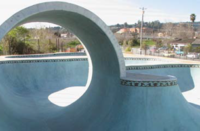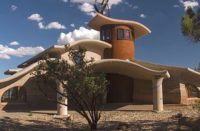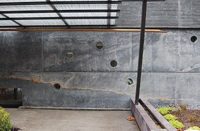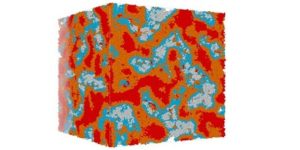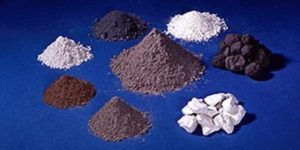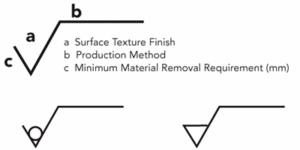
Fly Ash is a coal waste products that acts a lot like cement in the right recipe.
When you burn massive amounts of pulverized coal, one of the waste products is an ash that acts a lot like cement in the right recipe. That makes for a great relationship between coal-fired power plants and ready-mix concrete producers who use fly ash as an admixture.
This in turn works well for contractors and their customers, who can save a little on materials as well as take satisfaction in using a “green” building material that would otherwise go up the chimney or back in the ground. Fly ash scores well on the environmental scale not only because it is a recycled material, but also because it supplants the use of cement, which uses energy and raw materials to produce.
If ever there was a “win-win” relationship, it’s the one between the industries of coal combustion and concrete.
A stronger, more workable mix
Fly ash is a fine, light, glassy substance, consisting mostly of silica, that floats into the incinerator’s exhaust system. Historically, coal-burning industries have cleaned residual amounts out of their equipment and buried it in landfills or returned it to strip mines. The growth in coal-fired power plants has created hundreds of millions of tons of ash every year.
However, in recent times more and more fly ash is going into concrete blocks, masonry products and ready-mix. Fly ash is a pozzolan — to make cement, just add water. Combined with lime and water, it forms a mixture that is similar to portland cement. But it is just an additive, rather than a replacement for portland cement. It is routinely used in 15 percent to 25 percent dosages in ready mix.
Like slag, fly ash is not a new development in the technology of concrete mixtures. Fly ash was mixed in the pours of Hoover Dam, and has held up just fine for more than seven decades. But it wasn’t until the 1980s that it became commonplace. At first, it was used as a cost-saving measure. But over the years, the concrete industry discovered that it has qualitative advantages.
One hundred percent portland cement? “That’s old school,” says Ian Paine, marketing director of the Western Canada Ready Mix Concrete group of Lafarge North America. “It doesn’t perform the way our customers need it to.” Concrete mixes designed with fly ash are better-performing materials for decorative work, Paine says. Setting times are more controlled, they allow more time for finishes such as stamping or carving in summer conditions, and they have less water demand, reducing the propensity to crack and craze.
Consistency is key
Fly ash is a supplementary cementing material (SCM) that usually acts as a water reducer in concrete, according to Steven Kosmatka, staff vice president of research and technical services at the Portland Cement Association. Like chemical water reducers, fly ash can make concrete stronger and more workable. In addition, fly ash enables the mix to flow better in pump hoses and makes it more workable under hand finishing, he says.
According to Kosmatka, there are few disadvantages to using fly ash concrete — even in decorative applications — as long as you work within guidelines established by the ACI and your local ready-mix producers.
One issue to watch out for is color. For example, Kosmatka says that buff-colored ash can impart a tan color to the concrete. Although rare, some fly ash has a form of iron that can result in an orange or red color in the concrete. But as long as the ash or slag are uniformly distributed and all batches have equal amounts of the same ash or slag, there shouldn’t be any problems with acid staining, Kosmatka says.
He advises contractors to follow the lead of their local ready-mix supplier, who knows the advantages and limitations of local materials. “Work with dosages and materials that the concrete producer is used to,” he says. Typical fly ash dosages range from 15 to 25 percent of the cementing materials, and some communities use up to 40 percent (usually a Class C ash). Higher percentages of fly ash used for the purpose of saving money can affect workability, finishability, rate of hardening, durability and strength. “Go with what the local industry has experience with,” he says.
There are always exceptions, but he advises contractors to do their homework before trying to break any new ground with mixtures. One thing that is of utmost importance: Be sure that the mix is exactly the same throughout the duration of the job.
The “green” advantage
Fly ash usually provides a little cost break, depending on the geographic location. If the source of portland cement is significantly closer than the fly ash, the cost differential may be minimal. However, there is a distinct marketing advantage. Fly ash gets high marks from advocates within the green building movement. Contractors in various parts of the country are getting more requests for green building materials, and some are making a pro-active effort to offer earth-friendly products to their customers.
The beneficial properties of fly ash and the need for consistency have put more demand on the product in recent years, says Paine of Lafarge. This has led coal plants to treat the ash less like a waste product and more as a profit center. They have invested more in recovery and distribution, leading to higher grades of ash and more even consistency.
At least one energy company has taken the additional step of investing in sizable concrete companies as a means of maximizing profits on its fly ash production. One of those is Headwaters Resources, which operates numerous coal combustion plants around the country. A major fly ash producer and distributor, this corporation has acquired concrete companies that use fly ash extensively, including FlexCrete Systems of Jordan, Utah; Eldorado Stone of Carnation, Wash.; and Southwest Concrete Products of Houston, Texas.
